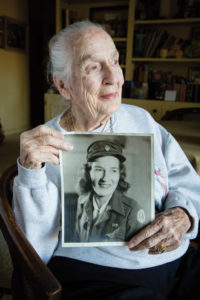JILL PITTS KNAPPENBERGER (1918-2020)

Jill Pitts was born 11 September 1918 in Evanston, Illinois. She married T. Gaillard Knappenberger in 1953. In November 1943, Jill graduated from the American Red Cross School at American University in Washington DC. She was sent to the European Theatre Operation of World War II in the largest convoy to leave the United States. There she worked in England and then landed on Utah Beach on 31 July 1944 and was assigned to the 8th Corps. They worked through Normandy, Brittany, Brest Peninsula and then to Bastogne, Belgium where they were cut-off during the Battle of the Bulge. Eventually they rejoined their group back in France and moved on with the troops through France and into Germany. She returned to the United States in 1945 and was discharged from the American Red Cross. Jill visited with her twin, Captain John Joseph Pitts III of the US Army in December 1944 just days before his death at the Battle of the Bulge:
“After graduation from the University of Illinois in June, 1941, Mr. Pitts was commissioned a Second Lieutenant in the Army and assigned to training draftees at Ft. Bragg, North Carolina until April, 1944 when he was assigned to the 106th Infantry Division as Captain of Battery A 590th Field Artillery Battalion. He was happy to be relieved of his teaching duties and get active “live” duty. In November, 1944 the 106th was sent to England for a week, then to the Ardennes, east of St. Vith, Belgium and stretched out over a 27 mile front. Normal disbursement for a division is only 3 miles. He arrived in Radscheid, Germany, December 11 or 12, 1944 and through a miraculous series of circumstances, I learned of his arrival that day, and left Bastogne, Belgium, where I had been an American Red Cross Clubmobile operator, with two days leave the 13th and 14th of December, 1944 and jeeped to St. Vith to locate the 590th Headquarters at Schoneberg, Germany. We were warned that the exposed Schneifel Ridge that we had to traverse was receiving much heavy enemy artillery fire and to proceed at our own risk going to the front. It was a very tense “white knuckle” drive and we arrived, unharmed, at the 590th Headquarters. Here, Colonel Lackey called Jack back to the Headquarters – not telling him his twin was there. Jack was completely surprised to see me, knowing only that I was in Belgium someplace and planning to contact me as soon as he had his men and equipment stationed and in order. He took me up front to his battalion and with pride and devotion, escorted me to all his heavy gun positions and introduced his twin sister to all his men. What a thrill it was!! I remember standing by one gun emplacement and looking across a few hundred yards to a tree covered hill, seeing the enemy and asking, “Where is the infantry?” and Jack replied that there was a platoon in back of us on our right and another in back of us on our left. Such was the way the newly arrived 106th Infantry Division was stretched out over a 27 mile front in that “quiet sector” of the Ardennes. We went back to his Battery Headquarters – one of a half dozen or so houses in the small community of Radscheid, Germany. We visited long into the night before retiring. The next morning I returned to Bastogne. On December 15 our crew of three American Red Cross girls made thousands of donuts, cleaned and packed our Clubmobile – a 2 1/2 ton GMC truck converted to a mobile kitchen and recreation center – with supplies, our Christmas gifts and belongings, for a 2 or 3 week assignment with the 106th. Saturday, December 16, as was our custom, we had lunch with Rear Corps Commander Colonel C. B. Warden and G-2 Lieutenant Colonel Kenny Clark. It was one of our crew member’s birthday and we planned to meet Jack and celebrate. We left Bastogne about 1pm and headed north and east to go to the 106th. En route we stopped at a small town to get decorations for the Christmas tree we planned for that night’s birthday celebration and having Jack join our party. G.I.s there told us we should buy candles as the enemy that morning had started serious “heavy artillery shelling” and had knocked out many of our generators. This was one of Europe’s coldest winters. The snow was deep, the skies overcast and the Air Force could not fly because of the severe conditions. We arrived at our destination – much to the shock and surprise of the 106th and immediately learned that we were in deep trouble. We were without communication and surrounded by the enemy. There was no escape. I was given the devastating news that my dearly beloved twin brother, Jack, had been killed that morning while aiding some of his men at a forward gun position – where I had been with him just two days before. I visited his temporary grave at Foy, Belgium after the “Battle of the Bulge” and learned that his death was instantaneous as a German 88mm shell fragment had pierced his helmet and skull. He is now buried in the beautiful American cemetery at Hamm, Luxembourg with 5,075 military dead, many of whom gave their lives in the “Battle of the Bulge.” General George S. Patton, who was killed after V-E day, is also buried there. Captain Pitts was awarded the Purple Heart.”
Jill’s story and photo is featured on the alumni pages of the website University of Illinois which you can read here.
Jill was interviewed by the Pacific War Museum in 2011 which you can listen to here.